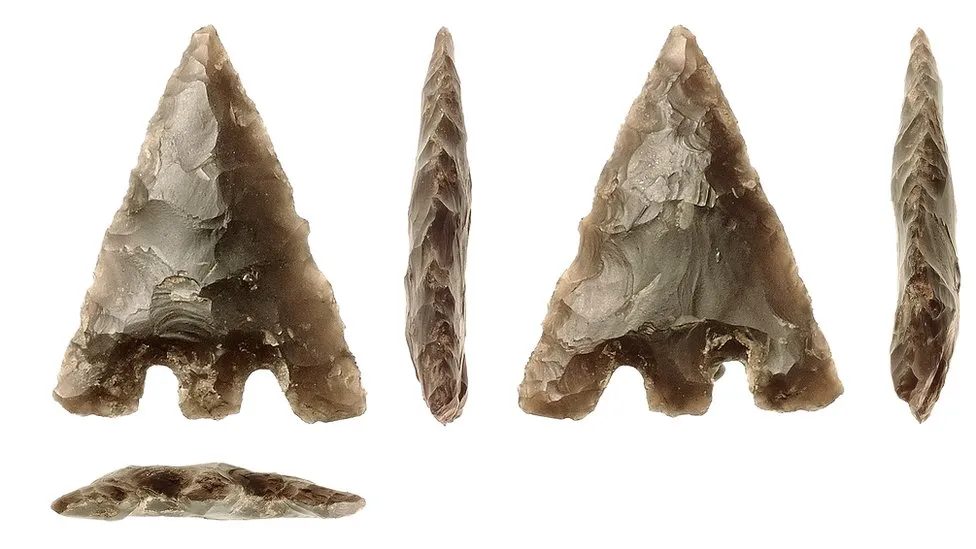
Why are so many arrowheads made of flint? Flint wasn’t the only material, but it is a fairly common rock, easy to break into flakes and it can be sharpened fairly easily.
The oldest arrowhead that has been found has been dated to 74,000 years ago. They were found in the lowlands of where northwest Ethiopia is now. They are made from a number of different types of rock, but their function is obvious. They are too small to be attached to the end of spears, so they are most likely arrowheads. The fact that these arrowheads have been found fully formed means that arrows were in use for a lot longer than this. It is also safe to assume that larger versions were used on spears far before they were used on arrows because throwing a spear is more natural than inventing a bow to fire an arrow. It is very difficult to guess at when the bow was invented because unlike the stone arrowheads, wooden arrow shafts, wooden bows, and whatever was used for the string, biodegrade pretty quickly. It is also probably safe to assume that the first arrows were sharpened sticks, followed by sticks with naturally sharpened rocks fastened to them, before people worked out how to make arrowheads.
Flint is not the only material used to make arrows. Early arrows were sometimes made of pieces of sharpened animal bone as well. However, flint and other similar rocks do appear to be the most common. Obsidian, a volcanic rock, is often found in places where it is common. The reason flint is so common, comes down to some of the properties that it has. Flint is a sedimentary rock, which means it was formed from compressed sediment at the bottom of the sea. Hundreds of millions of years ago, plankton called cocolithophores lived in the sea. They had calcium skeletons and when they died they sank to the bottom of the sea, becoming chalk. Bottom dwelling sea creatures dug holes through this chalk making burrows or looking for food. There were also sea sponges at this time and they had a skeleton made of silica. When they died, the silica became a gel that sank into the holes made in the chalk and hardened. This became flint. Because it is encased in chalk, which is very quickly eroded, flint stones are very commonly found lying on the ground in areas that used to be under the sea, making them very common. Another property is that flint is very hard, but it is also very fragile. When struck, it can shatter like glass, leaving sharp shards that can be razor sharp.
Before it was used for arrows, flint was probably used as a cutting tool. It was hand held, perhaps wrapped with something to protect the hand. Then it was probably used as an axe. Early humans would have realized that tying it to a stick increased the leverage and made it a more efficient cutting tool. Then probably came spears, and finally bows and arrows. Bows and arrows are very useful tools, but they demonstrate a huge leap forward in technology and society. To have a bow and arrow, early humans needed to understand the ability of a bent branch to store energy that could be used to catapult an arrow. They had to be able to make rope and tie nots. They had to have some understanding of aerodynamics. And one person probably didn’t make everything, so it would have required group interaction.
How did they make the arrowheads? They made them through a process called knapping. There are several parts to making an arrow head. The first step is to find a suitable piece. If one is lying around, great, if not, a larger piece of flint needs to be shattered to leave the shards that will become arrowheads. To shatter the flint into arrow head sized pieces, it first needs to be broken in half to expose the core. This can be done by hitting it at an angle with a harder stone. It has to be at an angle because the force continues out in a cone shape from the impact site. Once the core is exposed, it can be hit from above to shatter off a splinter. The second step is something called pressure flaking. You can’t make the sharp shaped edges by hitting the flint with a rock because it will just smash. To make the edges, a hard surface, such as the tip of an antler, is pressed very hard against the flint and then pulled forwards, taking a flake of the flint with it. By repeating this process. the flint can be shaped. Finally, it can be sharpened by sanding it with a rougher rock. Once the arrowhead is sharp, the base is shaped so that it can be tied to the arrow. And this is what I learned today.
https://www.bbc.com/news/uk-england-hampshire-34573230
Sources
https://phys.org/news/2024-03-toba-supereruption-dispersal-modern-humans.html#google_vignette
https://www.historic-uk.com/HistoryUK/HistoryofEngland/History-of-Arrowheads
https://en.wikipedia.org/wiki/Arrowhead
https://intarch.ac.uk/journal/issue26/5/1.html
https://www.wildernesscollege.com/making-arrowheads.html
https://kentdowns.org.uk/wp-content/uploads/2023/05/What-is-Flint.pdf
